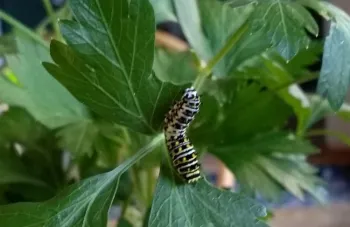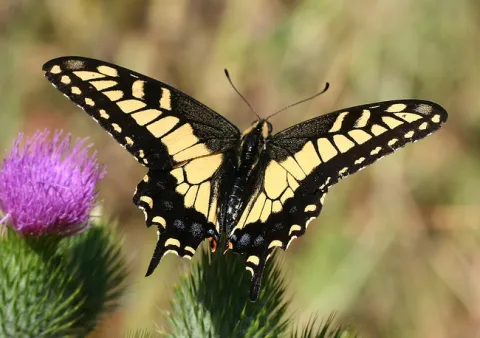
Parsley has been luxuriant in my garden this year. I wish I could take credit for it, but I have to confess that the largest patch of it sprouted voluntarily late last winter, just as the fall-planted parsley decided to go to seed. I dug some up and planted it in other parts of the kitchen garden. Because my garden is plagued by gophers, I've gotten in the habit of planting it in several places to make it harder for the gophers to find all of it, as parsley seems to be a favorite in their diet. Naturally, because I had lots of parsley, the gophers ignored it and have enjoyed other plantings. So I have had a constant supply of this quintessential garnish available all of this year.
Recently I harvested a large bunch of parsley because I needed it for a couple of dishes I was making: baba ghanoush and a lamb and bean stew. Of course there was more than I needed so I made a plain green (but aromatic!) bouquet of it and set it on the counter. Parsley stays pretty fresh this way, and it is convenient to have it washed and ready when I need it.

A quick internet search confirmed my identification. Art Shapiro's Butterfly Site (http://butterfly.ucdavis.edu/butterfly/Papilio/zelicaon) describes the first instars as looking like bird droppings, which is what I thought I was seeing at first.
Coincidentally, I've been working with the workshop team that has put on a four part series about creating a pollinator garden. As I've been mulling over what to plant this fall for bees, butterflies and hummingbirds (among others), I've been thinking about milkweed for monarchs, and all kinds of flowering plants for the pollinators. Every week it has been pointed out that a pollinator garden needs to have not only flowers for nectar and pollen, but host plants for the larvae. The Anise Swallowtail usually lays eggs on plants from the Apiaceae family. In the wild this might be hemlock or fennel; in my yard parsley is the favored plant.
Since I am trying to attract pollinators, I am willing to share the parsley with as many caterpillars as I can find. While Mr. Zelicaon is munching away on the parsley bouquet in the kitchen, I've been searching for more caterpillars in the vegetable patch. So far, no luck, although there is plenty of fodder for them. I suspect that birds have found them easy prey out there. Several years ago I had a potted parsley plant near the back door (another strategy to keep it safe from gophers) which hatched out three or four caterpillars. But they were short-lived; all disappeared over time.

By the way, I highly recommend the resource list that the pollinator workshop team created. It's available on our public website under the events tab: http://napamg.ucanr.edu/Workshop_References_and_Slides/Gardening_for_Pollinators_--_September_20_2020/
Master Gardeners are following recommended social distancing guidelines that keep everyone safe, Napa Master Gardeners are available to answer garden questions by email: mastergardeners@countyofnapa.org. or phone at 707-253-4143. Volunteers will get back to you after they research answers to your questions.
Visit our website: napamg.ucanr.edu to find answers to all of your horticultural questions.
Photo credits: Pat Hitchcock caterpillar; butterfly Calibas / CC BY-SA

